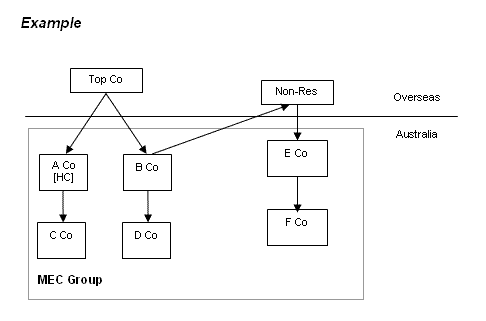Taxation Determination
TD 2005/42
Income tax: consolidation: cost setting: if a consolidated or MEC group qualifies as a transitional group, can the head company choose to retain the existing tax values of the assets of all the subsidiary members of the group irrespective of whether or not they are transitional entities?
-
Please note that the PDF version is the authorised version of this ruling.
FOI status:
may be releasedPreamble
| The number, subject heading, date of effect and paragraph 1 of this document are a 'public ruling' for the purposes of Part IVAAA of the Taxation Administration Act 1953 and are legally binding on the Commissioner. |
1. No. The choice to use existing tax values is only available in respect of subsidiary members that qualify as transitional entities as defined by section 701-1 of the Income Tax (Transitional Provisions) Act 1997 (IT(TP)A 1997). Subsection 701-5(1) of the IT(TP)A 1997 provides that if a consolidated group is a transitional group, its head company may choose that one or more of the group's transitional entities are 'chosen transitional entities'. The choice may be made by the head company on an entity by entity basis. Where the head company makes such a choice in relation to a transitional entity, the entity retains the existing tax values of its assets upon formation of the group (section 701-15 of the IT(TP)A 1997).
2. Special rules apply to subsidiaries of a consolidated group that are transitional foreign-held subsidiaries (TFHSs) of the group as defined in section 701C-20 of the IT(TP)A 1997. Whilst such a subsidiary may be a transitional entity, the head company of the group has no choice as to whether or not to retain the existing tax values of each asset of the subsidiary upon formation of the group. TFHSs of a consolidated group are taken to be a part of the head company of the group for the purposes of the operation of the tax cost setting provisions (section 701C-30 of the IT(TP)A 1997). It follows that such entities are required to retain the existing tax values for their assets upon formation of the group.
3. If the group is a MEC (multiple entry consolidated) group, section 701-1 of the IT(TP)A 1997 is modified by sections 719-2 and 719-161 of the IT(TP)A 1997 to apply in a similar way as it does to a consolidated group. In particular, the head company of a MEC group may make a choice, on an entity by entity basis, as to which transitional entities will be chosen transitional entities, subject to the rule that TFHSs and eligible tier-1 companies of a MEC group retain the existing tax values of their assets on formation of the group. As with TFHSs of a MEC group, eligible tier-1 companies of a MEC group are taken to be a part of the head company for the purposes of the operation of the tax cost setting provisions: see the general modifying rule in section 719-160 of the Income Tax Assessment Act 1997 (ITAA 1997). Again, as with TFHSs, the consequence is that eligible tier-1 companies are required to retain the existing tax values for their assets upon formation of the group.
4. The head company of a consolidated or MEC group may choose to retain the existing tax values for the assets held by a transitional foreign-held indirect subsidiary (TFHIS) provided the entity qualifies as a transitional entity.

5. A Co and B Co are the eligible tier-1 companies of a MEC group that satisfies the definition of a transitional group in section 701-1 of the IT(TP)A 1997 as modified by sections 719-2 and 719-161 of the IT(TP)A 1997. The members of the MEC group are A Co (an eligible tier-1 company and the head company of the MEC group), B Co (also an eligible tier-1 company), C Co, D Co, E Co (a company meeting the definition of a TFHS in section 701C-20 of the IT(TP)A 1997), and F Co (a company meeting the definition of a TFHIS also contained in section 701C-20 of the IT(TP)A 1997). B Co as an eligible tier-1 company of the top company and E Co as a TFHS are taken to be parts of the head company of the group for cost setting purposes. Like the head company of a consolidated group, the existing tax values of their assets are retained.
6. C Co and D Co (as subsidiaries meeting the requirements of the table in subsection 719-10(1) of the ITAA 1997), and F Co (as a TFHIS), may qualify as transitional entities assuming the conditions in section 701-1 of the IT(TP)A 1997 (as modified by sections 719-2 and 719-161 of the IT(TP)A) 1997) are met. On the basis that C Co, D Co and F Co are transitional entities, the head company of the MEC group may choose that any or all of the subsidiaries C Co, D Co and F Co be chosen transitional entities with the consequence that these entities retain the existing tax values for their assets when they become members of the group.
Date of effect
7. This Determination applies to years commencing both before and after its date of issue. However, it does not apply to taxpayers to the extent that it conflicts with the terms of settlement of a dispute agreed to before the date of the Determination (see paragraphs 21 and 22 of Taxation Ruling TR 92/20).
Commissioner of Taxation
19 October 2005
Previously issued as TD 2005/D10
References
ATO references:
NO 2004/12069
Related Rulings/Determinations:
TR 92/20
Subject References:
chosen transitional entity
consolidation
consolidated group
MEC group
subsidiary member of a consolidated group
subsidiary member of a MEC group
transitional entity
transitional foreign-held indirect subsidiaries
transitional foreign-held subsidiaries
transitional group
Legislative References:
TAA 1953 Pt IVAAA
IT(TP)A 1997 701-1
IT(TP)A 1997 701-5(1)
IT(TP)A 1997 701-15
IT(TP)A 1997 701C-20
IT(TP)A 1997 701C-30
IT(TP)A 1997 719-2
IT(TP)A 1997 719-161
ITAA 1997 719-10(1)
ITAA 1997 719-160
